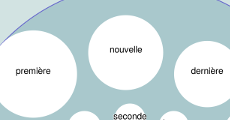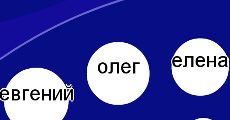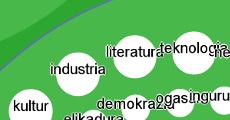jonsafari / Clustercat
Programming Languages
Projects that are alternatives of or similar to Clustercat
ClusterCat: Fast, Flexible Word Clustering Software
Overview
ClusterCat induces word classes from unannotated text. It is programmed in modern C, with no external libraries. A Python wrapper is also provided.
Word classes are unsupervised part-of-speech tags, requiring no manually-annotated corpus. Words are grouped together that share syntactic/semantic similarities. They are used in many dozens of applications within natural language processing, machine translation, neural net training, and related fields.
Installation
Linux
You can use either GCC 4.6+ or Clang 3.7+, but GCC is recommended.
sudo apt-get update && sudo apt-get install gcc make
make -j 4
macOS / OSX
The current version of Clang in Xcode doesn't fully support OpenMP, so instead install GCC from Homebrew:
brew update && brew install [email protected] libomp && xcode-select --install
make -j 4 CC=/usr/local/bin/gcc-9
Commands
The binary program clustercat gets compiled into the bin directory.
Clustering preprocessed text (already tokenized, normalized, etc) is pretty simple:
bin/clustercat [options] < train.tok.txt > clusters.tsv
The word-classes are induced from a bidirectional predictive exchange algorithm.
The format of the output class file has each line consisting of wordTABclass (a word type, then tab, then class).
Command-line argument usage may be obtained by running with program with the --help flag:
bin/clustercat --help
Python
Installation and usage details for the Python module are described in a separate readme.
Features
- Print word vectors (a.k.a. word embeddings) using the
--word-vectorsflag. The binary format is compatible with word2vec's tools. - Start training using an existing word cluster mapping from other clustering software (eg. mkcls) using the
--class-fileflag. - Adjust the number of threads to use with the
--threadsflag. The default is 8. - Adjust the number of clusters or vector dimensions using the
--classesflag. The default is approximately the square root of the vocabulary size. - Includes compatibility wrapper script
bin/mkclsthat can be run just like mkcls. You can use more classes now :-)
Comparison
| Training Set | Brown | ClusterCat | mkcls | Phrasal | word2vec |
|---|---|---|---|---|---|
| 1 Billion English tokens, 800 clusters | 12.5 hr | 1.4 hr | 48.8 hr | 5.1 hr | 20.6 hr |
| 1 Billion English tokens, 1200 clusters | 25.5 hr | 1.7 hr | 68.8 hr | 6.2 hr | 33.7 hr |
| 550 Million Russian tokens, 800 clusters | 14.6 hr | 1.5 hr | 75.0 hr | 5.5 hr | 12.0 hr |
Visualization
See bl.ocks.org for nice data visualizations of the clusters for various languages, including English, German, Persian, Hindi, Czech, Catalan, Tajik, Basque, Russian, French, and Maltese.
For example:
You can generate your own graphics from ClusterCat's output.
Add the flag --print-freqs to ClusterCat, then type the command:
bin/flat_clusters2json.pl --word-labels < clusters.tsv > visualization/d3/clusters.json
You can either upload the JSON file to gist.github.com, following instructions on the bl.ocks.org front page, or you can view the graphic locally by running a minimal webserver in the visualization/d3 directory:
python -m SimpleHTTPServer 8116 2>/dev/null &
Then open a tab in your browser to localhost:8116 .
The default settings are sensible for normal usage, but for visualization you probably want much fewer word types and clusters -- less than 10,000 word types and 120 clusters. Your browser will thank you.
Perplexity
The perplexity that ClusterCat reports uses a bidirectional bigram class language model, which is richer than the unidirectional bigram-based perplexities reported by most other software. Richer models provide a better evaluation of the quality of clusters, having more sensitivity (power) to detect improvements. If you want to directly compare the quality of clusters with a different program's output, you have a few options:
- Load another clustering using
--class-file, and see what the other clustering's initial bidirectional bigram perplexity is before any words get exchanged. - Use an external class-based language model. These are usually two-sided (unlexicalized) models, so they favor two-sided clusterers.
- Evaluate on a downstream task. This is best.
Contributions
Contributions are welcome, via pull requests.
Citation
If you use this software please cite the following
Dehdari, Jon, Liling Tan, and Josef van Genabith. 2016. BIRA: Improved Predictive Exchange Word Clustering. In Proceedings of the 2016 Conference of the North American Chapter of the Association for Computational Linguistics: Human Language Technologies (NAACL), pages 1169–1174, San Diego, CA, USA. Association for Computational Linguistics.
@inproceedings{dehdari-etal2016,
author = {Dehdari, Jon and Tan, Liling and van Genabith, Josef},
title = {{BIRA}: Improved Predictive Exchange Word Clustering},
booktitle = {Proceedings of the 2016 Conference of the North American Chapter of the Association for Computational Linguistics: Human Language Technologies (NAACL)},
month = {June},
year = {2016},
address = {San Diego, CA, USA},
publisher = {Association for Computational Linguistics},
pages = {1169--1174},
url = {http://www.aclweb.org/anthology/N16-1139.pdf}
}





